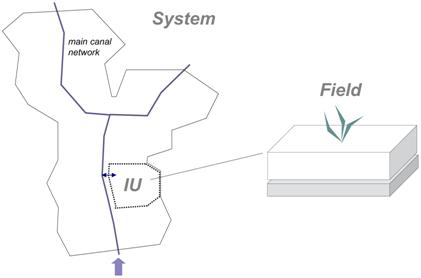OASIS (Options AnalysiS in Irrigation Systems) is a planning model for medium to large-scale canal irrigation systems (typically several thousand hectares). It specifically takes account of surface-groundwater interactions to assess the impacts on water use, depletion and productivity of a broad range of interventions in irrigated agriculture. Examples of such interventions include: lining of canals, development of storage, and introduction of alternative cropping patterns, water deliveries and on-farm irrigation practices. The model can thus be used to provide guidance to irrigation system managers and water policy-makers to make a more efficient and productive use of limited water resources in agriculture in the context of rising food demand, competitive water use from other sectors and the uncertainties brought about by climate change.
OASIS is based on water balance and includes a strong management component. The main innovation of the model lies in its capacity to capture irrigation return flows and integrate recycling of water through conjunctive drainage and groundwater use. OASIS also factors in non-irrigated areas, such as natural vegetation and fallow lands. These features distinguish the model from previous ‘integrated’ irrigation simulation models, which largely focus on canal delivery scheduling and incorporate only parts of the water balance within irrigation projects.
OASIS relies on a conceptual representation based on three nested levels: system, irrigation unit (IU) and field (Fig. 1). IUs are basic subdivisions of an irrigation system. They are described in a lumped fashion, without considering the spatial distribution of features within their boundaries. IUs thus define the actual spatial resolution of the model. Fields are 1-dimensional entities used to represent the various combinations of soil, land use and water management within each IU. They do not have any spatial identity within an IU. A network of main irrigation and drainage canals provides hydrological connections among IUs, and a variety of management rules can be defined to control key aspects of the water delivery, application, use and reuse processes.
Fig. 1. The three levels defining an irrigation system in OASIS (IU = irrigation unit).
Fig. 2 shows the components that make up a typical IU and how these are interconnected in the model. Each IU diverts water from one or more segments of the main irrigation (and/or drainage) canals. This water is then distributed within the IU to be applied on fields or stored in local reservoirs. In the process, ‘losses’ occur in the form of canal seepage, spills, surface runoff and deep percolation. Because it integrates a groundwater and a surface storage component, OASIS captures these ‘losses’ and allows recycling to be represented. Recycling of irrigation return flows is prevalent in many areas and, when overlooked, can lead to serious misconceptions about the efficiency and productivity of water, and the potential of water-saving interventions. In the model, recycling can occur within IUs (e.g. through groundwater pumping) but also among IUs, via the capture of surface or sub-surface return flows from upstream IUs.
Fig. 2. IU components and their connections (ET = evapotranspiration).
OASIS aims to provide a comprehensive picture of the water balance within irrigation projects. In particular, the model evaluates indicators geared to giving insights into the sources and benefits of water depletion – how is water depleted and what benefits are drawn from the depletion? These questions are absolutely critical to irrigation system planning and management in water-scarce environments.
The model is supported by a user-friendly graphical user interface (Fig. 3), which also gives access to the most relevant water balance components within fields, IUs and the whole system.
Fig. 3. Graphical user interface of OASIS
OASIS was developed by Dr. Nicolas Roost (formerly of IWMI). It is coded in Delphi. The model with a basic user manual is available for free and can be obtained from Dr. Xueliang Cai. More details on OASIS, together with an example of its application, can also be found in:
Roost, N., Cai, X.L., Turral, H., Molden, D., Cui, Y.L., 2008. Adapting to intersectoral transfers in the Zhanghe Irrigation System, China. Part II: Impacts of in-system storage on water balance and productivity. Agricultural Water Management 95, 685-697.
Please contact iwmi@cgiar.org for more information.




